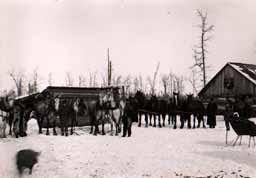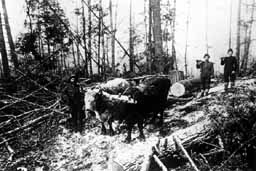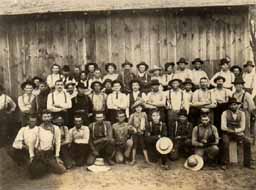

 |
 |
 Bruno Vinette's lumber camp |
In addition to the main camp building and the stable, there was a smaller, roughly constructed building for the making of shaved shingles. Only the best and straightest-grained pine was used for shingles. The log was sawed into blocks the length of a shingle and these were split into smaller blocks, and these again were split with an instrument called a frow into thin pieces for the shingles. These thin pieces were laid up on racks around the room, to allow them to be thawed out. They were then shaved smooth and tapered with a draw knife. The vise or clamp in which they were held while being shaved was called a "shingle horse." The shingles were packed two bunches to the thousand, instead of four as is the present custom. The shingle makers put in long days, working morning and evening by the light of the fire in the middle of the room. Two thousand shingles were an average day's work, and two and one-half or three thousand a big day's work. It may be hard to believe, but there was a man in the crew that winter by the name of Marshall, son of an American by a Chippewa squaw, who used to make five thousand shingles a day. Although there were a good many shaved shingles made that first winter, the principal part of the work was the getting out of hewed timber. Standing pine was plentiful and cheap and only the best part of high-grade trees was used. After the tree had been chopped down the part to be hewed was cleared of limbs and also peeled. The top was not cut off, but was left to steady the body of the tree for hewing. A line was then stretched and both sides of the round log were marked to the size of the finished timber. Standing on top of the log the woodsman, with a common ax, would score or notch the sides of the log and split away the wood somewhat near to the finish line, after which the broader was used. It took an experienced man to do good work with the broader, but there were a good many men here in those days who had got out hewed timber in Canada or in Maine, or had worked in the ship yards, and most of these men were experts. Standing on top of the log and swinging the broader over their heads, they would hew the timber square and true and almost as smooth as if planed. After the two sides of the log had been hewed the top would be cut off, and the partly hewed timber rolled over on to one of its flat sides, lines struck, and the other two sides hewed, thus finishing the stick of timber. |
 Jim Falls 1888 |
|
 |
|
 West Newton Log Rafting Works |